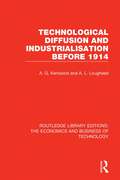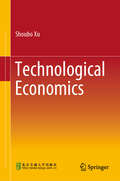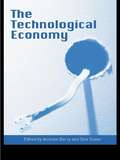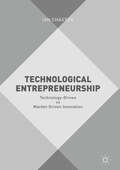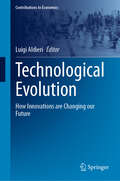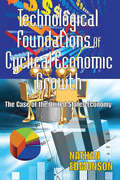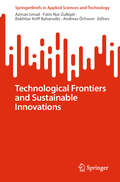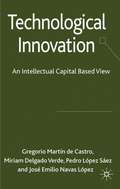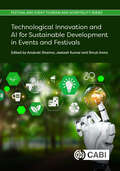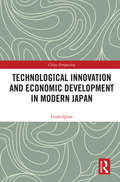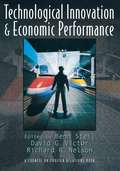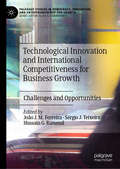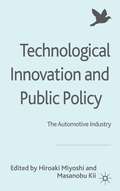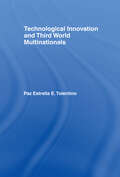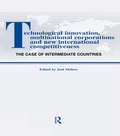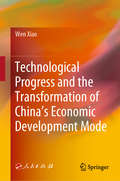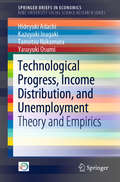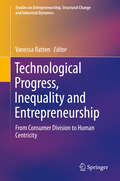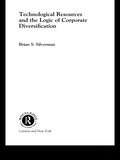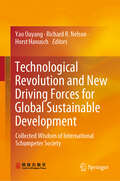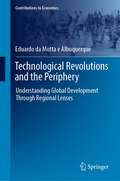- Table View
- List View
Technological Communities and Networks: Triggers and Drivers for Innovation (Routledge Studies In Technology, Work And Organizations Ser. #Vol. 32)
by Dimitris AssimakopoulosThe first book to analyze how new technologies are emerging against a background of continuing globalization of research and development activities. This unique book explores how technological communities and networks shape a broad range of new computer based technologies in regional, national and international contexts.Offering a critique of exist
Technological Diffusion and Industrialisation Before 1914 (Routledge Library Editions: The Economics and Business of Technology #24)
by A. G. Kenwood A. L. LougheedPublished in 1982 this is an introductory study of the international spread of modern industrial technology. The book considers the preconditions necessary for a country to adopt effectively modern industrial technology in the nineteenth century and the mechanisms by which this technology spread from one country to another. A global view is adopted and thus the book supplements others which are concerned with the industrial developmet of individual countries during the same period. It will be invaluable to anyone seeking an understanding of the early history of capitalism.
Technological Economics (Advances In Systems Science And Engineering (asse) Ser.)
by Shoubo XuThis book creatively puts forward the subject nature, object, system, theory, method and application of technical economics, and brings together the research achievements of 50 years, especially the latest research results. It is of great significance for the development of China's technical and economic disciplines and the cultivation of special talents for technical and economic development. It is of great significance for the solution of major technical and economic problems in economic and social development, and has a landmark significance in the history of world technical economics. The book can be used as teaching material for both the liberal arts, science and engineering students within higher education institutions, and as a leading cadre training source for engineers. Furthermore, it can facilitate readers engaged in policy making, program planning, macro control, evaluation of investment decision, feasibility studies, project with aspects such as government, consulting companies, banks, and financial personnel needs. Also this book can aid readers with engineering design, product development, business management, as well as with the needs of engineering and technical personnel and enterprise management personnel.
Technological Economy
by Don Slater Andrew BarryIn this major new collection, leading experts explore the multidisciplinary connections between technology and economy, drawing on new convergences between economic sociology and science and technology studies. Through theoretical and empirical studies, the authors investigate: * economics and economic knowledges as technologies* the economies as socio-technical arrangements* the nature of innovation* the role of technological mediations in representing and performing economies. This revealing book, ideal for those with an interest in contemporary social theory, interrogates the evidence for the contemporary claims about the emergence of the ‘new economy’ and ‘knowledge-based economies’ and sheds new light on the relationship between economy and culture.
Technological Entrepreneurship
by Ian ChastonThis comprehensive book responds to the growing demand to study entrepreneurship as a key driver of innovation and competitive advantage. Challenging the existing idea that technological entrepreneurship exists predominantly in SMEs and as a result of market demands, the author argues that a commitment to entrepreneurship remains the most effective strategy for sustaining wealth generation for both organisations and entire nations. The aim of Technological Entrepreneurship is to provide the reader with additional knowledge and understanding of the concepts associated with the exploitation of technological entrepreneurship, and to demonstrate how associated management principles are somewhat different to those utilised in market-driven entrepreneurship. Validation of presented theoretical concepts is achieved through coverage of processes and practices utilised by real world organisations seeking to achieve maximum wealth generation, with specific emphasis on how technological entrepreneurship is the source of disruptive innovation within service sector organisations and how the philosophy is causing fundamental change in the provision of healthcare.
Technological Evolution: How Innovations are Changing our Future (Contributions to Economics)
by Luigi AldieriInnovation plays an important role in ensuring the right balance in environmental systems and in ensuring social welfare in different spheres of society. This volume sheds light on innovation processes through the analysis of research and development expenditures (R&D) or patent data. In particular, the chapters further explore the innovation process of firms, the relative impact of employment, and the interactions with environmental issues.The book further examines the role of technological innovation in the energy and agricultural sectors from an environmental point of view, discussing how it ensures significant improvements in energy efficiency, sustainable resource management, and recycling. Additionally, the central role of technological innovation in social welfare is discussed, including new technologies that can improve access to education, health, and employment.The book features theoretical and empirical contributions from the fields of economics of innovation and relative public policies and will appeal to students, scholars, and researchers interested in a better understanding of innovation economics, environmental economics, employment effects of digital innovation, liquidity constraints, and productivity.
Technological Foundations of Cyclical Economic Growth: The Case of the United States Economy
by Nathan EdmonsonNew technology is intimately associated with increased economic growth. The tools people have and when they acquired them tells us much about cyclical patterns of growth. Those interested in encouraging economic growth would do well to look to the conditions that spur the origins, development, and impact of technology - as well as the circumstances that spur prolific periods of invention, the mother of technology. Despite general recognition of the connection between technology and growth, economists rarely have gotten to the heart of the relationship. Joseph Schumpeter and John Hicks were aware of the role of technology in cyclical variability, but their thoughts were not elaborated upon after they passed from the scene. Edmonson goes beyond formal theory, reviewing the record of economic growth and the role of technology in this growth. What does the technology future hold? One clue is where past prototype inventions that that have fomented massive technological innovations have come from. Some parts of the private sector, such as Bell Labs, have been important. The government, particularly in its sponsorship of defense related research, has delivered a number of inventions. Universities are very much in the picture in certain fields, such as nanotechnology. The challenges we face at the onset of the twenty-first century are covered in depth and with imagination by Edmonson. The book will spur much rethinking about economic futures.
Technological Frontiers and Sustainable Innovations (SpringerBriefs in Applied Sciences and Technology)
by Andreas Öchsner Azman Ismail Fatin Nur Zulkipli Bakhtiar Ariff BaharudinThis book takes a deep dive into the industrial sphere, exploring subjects such as aerospace development, knowledge management in higher education, and the emergence of a nation as a player in the global space race. This insightful compilation of chapters offers an essential guide to navigating the complexities of modern industry, offering valuable insights and solutions to propel businesses and society toward a sustainable future.
Technological Innovation
by Gregorio Martín de Castro Miriam Delgado Verde Pedro López Sáez José Emilio Navas LópezConsidering the uncertain, competitive and dynamic current environment, the capability to create and apply new knowledge represents one of the main sources of sustained competitive advantage (Teece, 1998; Nonaka, 1991; Almeida, Song& Grant, 2002). Intellectual capital stocks, as well as their different manifestations play a critical role for effective development of the firm technological innovation (Teece, 1998; Subramaniam and Youndt, 2005). Wedevelop an improved and extended theoretical and empirical propositions about it can labeled 'An Intellectual Capital Based-View of Technological Innovation'. The book is about the role of knowledge stocks or intellectual capital blocks (human, structural, and relational capital) on two technological innovation processes typologies (process/product). This method obtains evidence-driven models that depict the nature of innovation management, since it is shown the significant and positive influence of each intellectual capital components on product and process innovation. "
Technological Innovation and AI for Sustainable Development in Events and Festivals (Festival and Event Tourism and Hospitality Series)
by Anukrati Sharma Jeetesh Kumar Shruti AroraFrom sustainable event planning to the influence of VR, AI, and mobile applications on tourist behaviour, this book explores the dynamic landscape where innovation meets tradition. It studies the intersection of green technologies, sustainable infrastructure, and the delicate balance between cutting-edge tools and the intrinsic emotional aspects of human engagement. Aligned with the United Nations' 17 Sustainable Development Goals, the book highlights AI's potential to drive meaningful contributions to a sustainable future. It anticipates the imminent transformation of festivals and events through technological innovation and AI implementation. It will allow the reader to gain insights into how automation streamlines logistics, optimizes marketing efforts, and enhances the overall attendee experience. The book offers readers: · A cutting-edge exploration of the transformative impact of technologies and artificial intelligence on the events and tourism industries. · Oversight of how new technology can align with the United Nations' 17 Sustainable Development Goals - readers can anticipate insights into how AI can contribute meaningfully to understanding and addressing pressing global challenges. · Practical insights for stakeholders including actionable insights that go beyond theory. It will be an essential reference for academic researchers and practitioners within events and tourism management.
Technological Innovation and Economic Change in the Iron Industry, 1850-1920 (Routledge Library Editions: The Economics and Business of Technology #5)
by Robert A. BattisOriginally published in 1989 this study examines some new facets in the development of the iron industry in the USA between 1839 and 1921 through the study of an individaul form, namely the Thoms Iron Company, one of the leading merchant furnace companies. It charts the end of the anthracite iron age and the changes which brought about the advent of open-hearth steel and integrated steel works. The book discusses the problems the managers of the firm faced with the appearance of industrial innovations which tended to undermine their firm's very existence and provided a new set of optimal conditions necessary for the survival of the firm. It provides a clear understanding of the destructive forces of industrial innovation and the place of creative entrepreneurship in the survival of the firm.
Technological Innovation and Economic Development in Modern Japan (China Perspectives)
by Guan QuanThis book analyzes the relationship between technological innovation and economic development in Japan before World War II. Guan Quan deploys econometric analysis, multivariate statistical analysis and case studies from different industries to shed light on technological innovation in the Japanese context with particular emphasis on the importance of the patent system. A great deal of new inventions and patents in this period led to fast economic growth in Japan characterized by the simultaneous development of both traditional and modern industries. These insights help reshape the understanding of Japan's economic development and industrial advancement at an early stage and provide pointers to developing countries as to how human capital, social capabilities and thereby technological innovation can figure in economic growth. The book will appeal to academics of the East Asian economy, development economics and modern economic history as well as general readers interested in the miracle of the Japanese economy as the first to achieve economic development and modernization among non-Western countries.
Technological Innovation and Economic Performance
by Benn Steil; David G. Victor & Richard R. NelsonInformation technology accounts for over one-third of recent U.S. GDP growth and nearly two-thirds of corporate capital investment. ''The New Economy'' appears omnipresent, but little is actually known about its workings.This seminal volume brings together the research and critical thinking of many of the world's top macro and micro economists to provide a unique, multifaceted perspective. Through the use of detailed, up-to-date country and industry studies, this book provides the most authoritative and detailed analysis ever assembled into the causes of technological innovation and its relationship to economic performance. The country studies cover the United States, Japan, Germany, France, the United Kingdom, and the Nordic states. Nine industry studies examine the Internet, computers and semiconductors, banking, securities trading, venture capital, energy, agricultural biotechnology, pharmaceutical biotechnology, and automobiles.Commissioned and brought together for the research project by the world-renowned Council on Foreign Relations, the authors have produced one of the most important compendia in applied economics to be published in recent times.The contributors are Charles Calomiris, Ian Domowitz, Robert Evenson, Charles Fine, Robert Gordon, Richard Langlois, Josh Lerner, Markku Malkamäki, Patrick Messerlin, Joel Mokyr, David Mowery, Richard R. Nelson, Stephen Nickell, Gary Pisano, Adam Posen, Daniel Raff, Horst Siebert, Timothy Simcoe, Benn Steil, Michael Stolpe, John Van Reenen, David Victor, and Matti Virén.
Technological Innovation and International Competitiveness for Business Growth: Challenges and Opportunities (Palgrave Studies in Democracy, Innovation, and Entrepreneurship for Growth)
by Hussain G. Rammal João J. M. Ferreira Sérgio J. TeixeiraThis book explores how companies combine technological innovation and competitive actions that create new opportunities for business growth in the international market. The complexity of designing today’s technology platforms requires profound knowledge in multiple areas. Technology development and commercialization as an ongoing competitive process involves enabling and inhibiting mechanisms, which govern the speed and acceleration of technological innovation. To compete more effectively, potential competitors are using coopetition and pooling their resources for shared gain in areas where they do not compete directly. Thus, a thorough examination of the current paradigms, theories, and frameworks is needed to increase our understanding of the technology-innovation-competitiveness linkages of business growth. This book brings together recent developments and methodological contributions within technological innovation, international competitiveness, and business growth that bridge the existing gaps and simultaneously advances the debate on this research topic.
Technological Innovation and Public Policy: The Automotive Industry (Palgrave Macmillan Asian Business Series)
by Hiroaki Miyoshi Masanobu KiiTechnological innovation is a necessary but insufficient ingredient for solving the problems of society caused by the widespread use of automobiles. For this reason, a host of public-policy solutions have been devised and implemented - with varying results - to maximize the efficacy of innovative automotive technologies in combating societal ills. Focusing on safety and environmental protection issues, this book provides incisive, cutting-edge theoretical analysis that evaluates the impact of new automotive technologies and the associated public policies on social welfare. It discusses how new automotive technologies can improve social welfare and why public policies are needed to promote the adoption of these technologies. The contributors analyze taxes, subsidies, and regulations - and the decision-making processes behind them - to identify policy directions that optimize the social benefits of emerging automobile technologies. The reader will gain an appreciation of how policies can break down barriers and exploit market innovations for the common good.
Technological Innovation and Third World Multinationals
by Paz Estrella TolentinoThis examines the relationship between technological growth and outward direct investment from firms in Asia and Latin America which has become increasingly siginificant as these countries develop.
Technological Innovation in Retail Finance: International Historical Perspectives (Routledge International Studies in Business History)
by Bernardo Bátiz-LazoThis edited volume offers a new and original approach to the study of technological change in retail finance. Documenting developments in the US alongside case studies from Mexico and Europe, Technological Innovation in Retail Finance addresses the variety of financial institutions that populated the markets for retail finance. It offers a massive research base reflecting not only breadth of contributor interests, but also a unity of purpose that comes from several workshops and comments on each other's work. Technological innovation had a major role in the shaping and developing of administrative procedures, routines, and capabilities in organizations offering retail financial services. Indeed, with the exception of contemporary case studies for the UK, the current ‘state of the art’ in the study of the computerization of financial services from an historical perspective is overwhelmingly focused on developments in the USA. This volume overcomes the usual bias towards the so called ‘Atlantic continuity’ in the understanding of technological change related to applications of information and telecommunication technologies (ICT) by offering a number of sources of distinctiveness. It shows when and how technological change altered the competitive intensity in the markets for retail finance.
Technological Innovation, Industrial Evolution, and Economic Growth (Studies on Industrial Productivity: Selected Works)
by Sanjaya PanthFirst Published in 1998. Routledge is an imprint of Taylor & Francis, an informa company.
Technological Innovations, Multinational Corporations and the New International Competitiveness: The Case of Intermediate Countries (Routledge Studies in Global Competition)
by JosThe aim of this book is to contribute to a better understanding of those intermediate countries with specific reference to two relevant international areas; those countries of southern Europe whose dynamic is very much influenced by the phases of European construction, and in countries of Latin America where the opening up process has changed the traditional role played by multinational corporations.
Technological Progress and the Transformation of China’s Economic Development Mode
by Wen XiaoThis book explores how technological progress accelerates the transformation of economic development by adopting a fundamental logical approach to technological progress, intensive inputs, and promotion of productive efficiency to transformation of economic development. It investigates the internal mechanisms and the choice of corresponding modes that initiate technological progress to accelerate the transformation of economic development at three basic research levels: micro-enterprise level, mid-industry level and macro-economy level. Based on the above research, the book summarizes four dimensions facilitating the transformation: agricultural intensification, new industrialization, modernization of the service industry and the advanced manufacturing industry, and linkage of the modern service industry. This book is especially valuable in its hierarchical categorization covering theoretical, empirical, industrial and strategic exploration. On one hand, it analyzes the mechanisms and approaches influencing the transformation of economic development driven by technological progress from both theoretical and empirical perspectives. On the other hand, based on the introduction of advanced international experiences, it probes into the guarantee basis for the strategic implementation and the corresponding mode choices of the transformations. Furthermore, it offers specific policy proposals from both the macro level of how technological progress promotes the transformation of economic development and the micro level covering the agricultural, industrial and service industries.
Technological Progress, Income Distribution, and Unemployment: Theory and Empirics (SpringerBriefs in Economics)
by Hideyuki Adachi Kazuyuki Inagaki Tamotsu Nakamura Yasuyuki OsumiThis volume develops original methods of analyzing biased technological progress in the theory and empirics of economic growth and income distribution. Motivated by sharp increases in wage and income inequalities in the world since the beginning of the new century, many macroeconomists have begun to realize the importance of biased technological changes. However, the comprehensive explanations have not yet appeared. This volume analyzes the effects of factor-biased technological progress on growth and income distribution and shows that long-run trends of the capital-income ratio and capital share of income consistent with Piketty’s 2014 empirical results emerge. Incorporating the modified version of induced innovation theory into the standard neoclassical growth model, it also explains the long-run fluctuations of growth and income distribution consistent with the data shown in Piketty. Introducing a wage-setting function, the neoclassical growth model is modified to account for unemployment as well as to examine the dynamics of unemployment and the labor share of income under biased technological progress. Applying a new econometric method to Japanese industrial data, the authors test the key assumptions employed and important results derived in the theoretical part of this book.
Technological Progress, Inequality and Entrepreneurship: From Consumer Division to Human Centricity (Studies on Entrepreneurship, Structural Change and Industrial Dynamics)
by Vanessa RattenAlthough there have been considerable technological advances over the past decade, particularly in terms of mobile applications, much remains unknown about their effect on societal progress. This book focuses on how inequality and entrepreneurship are both by-products of technological change. The book provides insights into how society has shifted from consumer division to human centricity, and helps readers gain a better understanding of the positive and negative effects of entrepreneurship.
Technological Resources and the Logic of Corporate Diversification (Routledge Studies In Global Competition Ser. #Vol. 13)
by Brian S SilvermanThis impressive book sees the author applying and extending the resource based view of the firm to explain and predict the strategy of corporate diversification.Technological Resources and the Logic of Corporate Diversification is an original and authoritative book that will be extremely useful to academics and students in such disciplines as busin
Technological Revolution and New Driving Forces for Global Sustainable Development: Collected Wisdom of International Schumpeter Society
by Yao Ouyang Richard R. Nelson Horst HanuschThis book collects the insights from the researchers of International Schumpeter Society and focuses on the interaction of technology development and global sustainable development. It explores in the following four areas: first, the evolutionary process of economic transformation, the effects of disruptive technological changes, and complexity issues in economics; second, the development trends of contemporary technological transformation, the path of sustainable development driven by technological innovation, and the opportunities and challenges brought by the digital economy; third, technological innovation and industrial upgrading in developing countries, the technological and institutional reasons for leapfrog development in latecomer countries, and the technological innovation driving the accelerated iteration of emerging industries; fourth, the collaborative mechanisms of innovation and entrepreneurship, the role of innovation and entrepreneurial spirit, and the transformation of education and entrepreneurial methods to adapt to the digital economy. Through a comprehensive exploration of these issues, it systematically addresses the significant question of how to seek new impetus for global sustainable development from the perspective of new technological transformation amid a global economic downturn.
Technological Revolutions and the Periphery: Understanding Global Development Through Regional Lenses (Contributions to Economics)
by Eduardo da Motta e AlbuquerqueThis book evaluates the uneven propagation of technological revolutions, investigating the roots of this phenomenon in the absorptive capabilities that are built by countries and regions at the periphery. To understand this global process, this book looks to two dimensions: time and geography. Temporally, the book follows the sequence of technological revolutions in the last 250 years. With regard to geography, the book studies five different regions at the periphery—China, India, Africa, Russia and Latin America—to understand how they differ in the institutional processes that shape their absorptive capabilities. Focusing on each technological revolution and its impact on those five peripheric regions, the chapters illustrate how each region coped with each shock wave emanating from the center. Providing a truly global outlook of a complex system with a dynamic nature, this book will be of interest to researchers and students of development economics, the economics of innovation, evolutionary economics, and the economics of science and technology.

